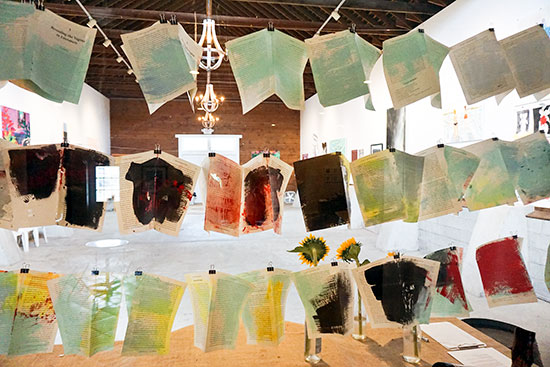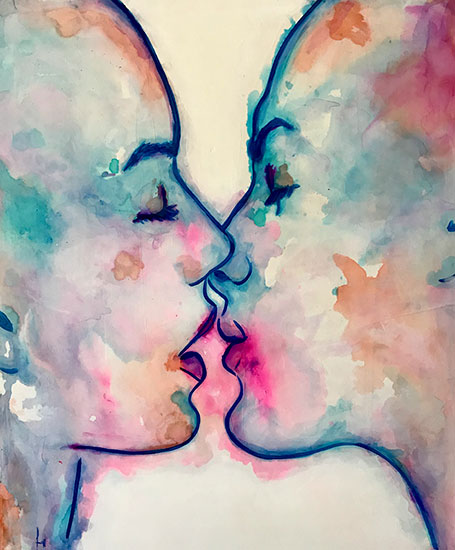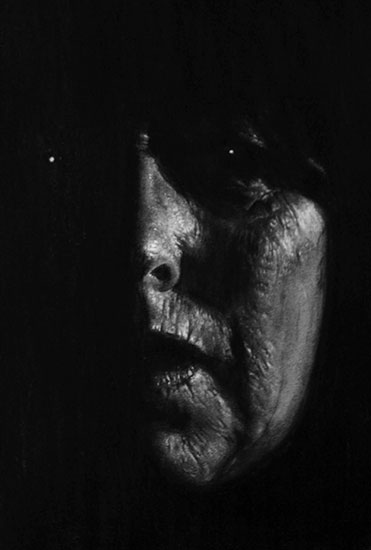At Castello di Borghese Vineyard on the North Fork, a large window divides the entryway of the tasting room from a barn-like rear gallery. Currently obscuring the view through the glass is an artwork by Chamberlin Newsome that consists of a number of extracted book pages. Painted over messily in a mix of different colors, the pages hang suspended by paper clips from three tiers of thread. Titled The Host, and originally dating to 2017, this site-specific version of the work at the Cutchogue, NY vineyard was installed by artist-curator Kara Hoblin.
.

"The Host" by Chamberlin Newsome, 2018. Installation View, Acrylic and Oil on Book Pages. Image courtesy of Anne Sherwood Pundyk.
.
On entering the gallery the appropriation of religious iconography by this iteration of The Host becomes apparent, for its placement below a light-filled arched window and behind a table transforms the work into an altarpiece. That the double pages are arranged in three tiers, alluding to the doctrine of the Holy Trinity, further emphasizes the installation’s devotional nature.
But instead of the untainted communion wafer of the Christian eucharist, Newsome’s host consists of painted-over pages from Emma L.E. Rees’s book, “The Vagina: A Literary and Cultural History.” By using Rees’s book, and through the irreverent usurpation of Christian symbolism, The Host becomes a celebratory altarpiece of women’s bodies in all their messy, life-giving glory.
As a provocative representation of female agency and of the creative potentialities of collaboration, The Host is an ideal portal to the group show presently on view in the Borghese Winery gallery, “WE: Women Empowering Women.” Co-curated by Hoblin and fellow artist Anne Sherwood Pundyk, the exhibition is in the spirit of other artist-run, collaborative ventures, such as the Yams Collective, CRUSH Curatorial, and the North Fork Art Collective.
.

"WE: Women Empowering Women" 2018, Installation View. Image courtesy of Anne Sherwood Pundyk.
.
At Borghese the focus is on work made by women, most of whom are from New York City and Long Island, and some of whom are connected to the Brooklyn-based artists community, Lady Painters. By choosing a miscellany of artworks of differing styles and techniques (with a concentration on painting and drawing), and mixing color and monochrome examples, the resulting exhibition testifies to the array of expressive possibilities being pursued by women artists today.
A number of works featured in “WE” engage with the natural world. These range from evocations in pastel hues, like Gina Gilmour’s large oil seascapes and Melanie Parke’s ode to summer, Sighting (2016), to paintings that express nature’s darker, sublime side, such as Dana James’s dramatic landscapes, State of Grace (2018) and Caldera in Eternal Blue (2017).
Emma Ballou’s double-canvas Cherry Blossom Veins (2018) is particularly transportive, taking the viewer to a patch of grass below the branches and blooms of a cherry tree. For Kelsey Shwetz, women’s everyday spaces and activities—a recreation room, a young woman cutting her bangs—are themselves imaginatively transformed into brightly colored landscapes filled with tropical botanicals.
.

"Untitled (Cut 2)" by Sarah Pettitt, 2018. Iron Oxide on Canvas, 34" x 18". Image courtesy of the Artist.
.
More viscerally unsettling is the all-over composition by the British artist Sarah Pettitt, Untitled (Cut 2), 2018. Painted with iron oxide in a single plane, the canvas is ruptured by a number of cuts that appear hastily stitched together. In combination with the work’s rusty, reddish-brown coloring, these sewn sections call to mind both track marks across the earth and raw wounds. It is a brilliantly confronting image of pared-back beauty and of environmental and human damage.
Other artists focus their concentration on the human figure. Mary Twomey presents modern renditions of ancient female fertility goddesses in Guardian Angel # 2 and Cave Painting Series (both 2016), while Loren Erdich and Verona Penalba both capture the sublimity of human interaction. In I Will Touch a Hundred and Not Pick One (2016), made with raw organic pigments mixed with water, Erdich melds the figurative and the abstract to create a fantastically gleeful, slightly manic, representation of a couple.
.

"Connection" by Verona Penalba, 2018. Mixed Media, 30" x 36". Image courtesy of the Artist.
.
Penalba, on the other hand, depicts the quietly intimate, tremulous moment before a kiss in Connection (2018). Two non-gendered people are depicted with their eyes closed as they lean towards each other, the deep blue lines that contour their features tying them together formally. Recalling the recent “erotic landscapes” of Marlene Dumas (reviewed for Hamptons Art Hub), wherein the sensuous mark-making qualities of paint visually replicate the thrill of emotional and sexual pleasure, the smudges of different colors that model the figures’ profiles appear to thrum.
Such is the masterful handling of light and shadow and the careful attention to detail of the two included portraits by Sarah Satory that on first approach the viewer would be forgiven for mistaking either one of them as a black-and-white photograph. Each is a close-up of a woman, her face emerging from darkness, wrinkles unflinchingly highlighted by light.
.

"Charcoal Analysis III" by Sarah Satory, 2011. Charcoal and Conte on BFK Paper, 23" x 21". Image courtesy of the Artist.
.
Yet is is only by consulting the wall panel, and with very close looking, that the true medium of charcoal and Conté crayon reveals itself. And while the titles, Charcoal Analysis II and Charcoal Analysis III (both 2011), also specify their formal means, the drawings are more than just technically astounding; in the tradition of Rembrandt, they are strikingly penetrative studies of individuals.
A large grouped arrangement of floral still lifes by Jenn Dierdorf is a fitting tribute to the creative richness of female artistic community currently on view in the Borghese Winery gallery. While bouquets of flowers are more readily associated with the feminine, in art history there are many more widely known depictions of floral still lifes by men than by women. In these works on paper, Dierdorf would seem not only to embrace the time-honored genre but, by abstractly effacing parts of the representational subject matter, she also subverts it, creating something new.
By arranging a vast collage of these acrylic studies, both in color and monochrome, the curators assist in the artistic endeavor. And, if the heartening, generative results of “WE: Women Empowering Women” are anything to go by, let’s hope to see many more of these artist-led exhibitions and collaborations in the near future.
_______________________________
BASIC FACTS: “WE: Women Empowering Women” is on view July 28 to September 10, 2018 at Castello di Borghese Vineyard, 17150 Rte. 48, Cutchogue, NY 11935. castellodiborghese.com
_______________________________
Copyright 2018 Hamptons Art Hub LLC. All rights reserved
